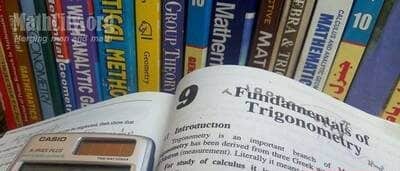
Chapter 09: Fundamentals of Trigonometry
The fundamentals of Trigonometry encompass the basic principles and concepts that form the foundation of this branch of mathematics. Trigonometry deals with the relationships between angles and the sides of triangles. It has wide-ranging applications in fields such as physics, engineering, navigation, and more.
Here are some key fundamentals of Trigonometry:
Angles: Trigonometry revolves around the measurement of angles. Angles are typically measured in degrees (°) or radians (rad). A complete revolution around a point corresponds to 360 degrees or 2π radians.
Right Triangle Trigonometry: Trigonometry initially focuses on right triangles, which have one angle measuring 90 degrees (a right angle). The relationships between the angles and sides of right triangles are defined by three primary trigonometric functions: sine (sin), cosine (cos), and tangent (tan). These functions relate the ratios of the lengths of specific sides of a right triangle.
- Sine (sin): The sine of an angle is the ratio of the length of the side opposite the angle to the hypotenuse.
- Cosine (cos): The cosine of an angle is the ratio of the length of the adjacent side to the hypotenuse.
- Tangent (tan): The tangent of an angle is the ratio of the length of the side opposite the angle to the adjacent side.
Trigonometric Functions and Identities:
Trigonometric identities are equations involving trigonometric functions that hold true for all values of the angles involved. These identities are used to simplify expressions, prove equations, and solve trigonometric equations.
Trigonometric functions extend beyond right triangles to all angles. These functions are periodic and can be defined for any angle in the unit circle. The primary trigonometric functions (sine, cosine, and tangent) are accompanied by their reciprocal functions (cosecant, secant, and cotangent), which are ratios of the lengths of the sides in relation to the reference angle.
Trigonometric Ratios and Unit Circle:
Trigonometric ratios are fundamental to Trigonometry. They establish relationships between the angles and sides of a triangle. The unit circle, a circle with a radius of 1, is often employed to define trigonometric functions for angles beyond right triangles.
Trigonometric Equations and Applications:
Trigonometry finds extensive applications in various fields. Trigonometric equations involve trigonometric functions and are utilized to solve problems related to angles, distances, heights, and more. Trigonometry is widely used in fields such as physics, engineering, architecture, astronomy, navigation, and surveying.
By understanding and mastering the fundamentals of Trigonometry, individuals gain the ability to analyze angles and triangles, solve problems involving angles and distances, and comprehend the trigonometric functions and identities necessary for advanced applications and problem-solving.
Contents & summary
Introduction
- Units of Measures of Angles
- Sexagesimal System
- Conversion from D∘M′S′′�∘�′�″ to the decimal form and vice versa
- Circular System (Radians)
- Relation between the Length of an arc of a Circle and the Circular measure of its Central angle
- Conversion of Radian into Degree and vice versa
- Exercise 9.1
- General Angle (Coterminal Angle)
- Angle in the Standard Position
- Trigonometric Function
- Trigonometric Function of any Angle
- Fundamental Identities
- Signs of the Trigonometric Function
- Exercise 9.2
- The Values of Trigonometric Functions of acute angles 45∘,30∘,60∘45∘,30∘,60∘
- The Values of Trigonometric Functions of acute angles 0∘,90∘,180∘,270∘,360∘0∘,90∘,180∘,270∘,360∘
- Exercise 9.3
- Domains of Trigonometric Functions and of Fundamental Identities
- Exercise 9.4

